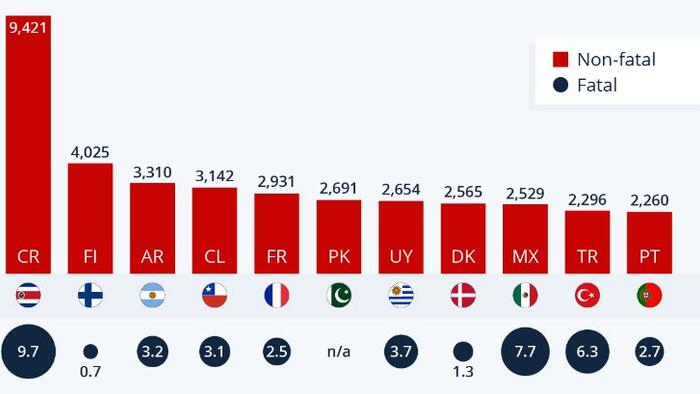In many regions of the world, workplace safety has drastically increased over the last couple of decades, ensuring healthy working environments for many employees. As the collapse of Rana Plaza, a nine-story building in Bangladesh housing several garment workshops connected in large part to the fast fashion industry, ten years ago shows, there is still lots of room for improvement though. Research quoted by the International Labor Organization (ILO) suggests that in 2017 alone, 2.8 million people died and a further 374 million people suffered non-fatal injuries in their line of work.
As Statista’s Florian Zandt details below, according to data from ILO, Costa Rica currently has the highest number of work-related injuries with 9,421 non-fatal as well as 9.7 fatal occupational injuries per 100,000 workers in 2016. For decades, the nation’s economy relied heavily on agriculture and tourism. Since the turn of the millennium, manufacturing and industry have surpassed the agricultural sector, with companies like Intel or Procter & Gamble heavily investing in the country. According to media reports, Intel’s microprocessor facility was responsible for five percent of the total GDP and 20 percent of all Costa Rican exports in 2006.
You will find more infographics at Statista
Anecdotal evidence from other countries suggests that the aforementioned focus on industry and manufacturing might also be responsible for the high number of fatal occupational injuries. While Costa Rica doesn’t provide segregated data on fatal injuries by economic activity, Mexico and Turkey, which rank ninth and tenth in terms of non-fatal as well as second and third in terms of fatal occupational injuries, do. In Mexico, for example, out of 806 work-related deaths, 118 people died in the manufacturing, 76 in the construction and 86 in the transportation and storage sectors. Turkey registered 386 deaths in construction, 297 deaths in manufacturing and 258 deaths in transportation and storage out of a total of 1,394.
Nations known for their textile industries like Pakistan and Portugal also make the top list of the countries with the most occupational injuries per 100,00 workers. While independent auditors regularly check and sign off on labor practices and working conditions in the fashion industries of the aforementioned countries, the reality is often far grimmer than official assessments suggest. A report by NGO Human Rights Watch on Pakistan’s garment workers from 2019, for example, points out companies failing to pay their employees the minimum wage, a lack of written contracts, firings of pregnant women and pay deductions for sick days.
Loading…











